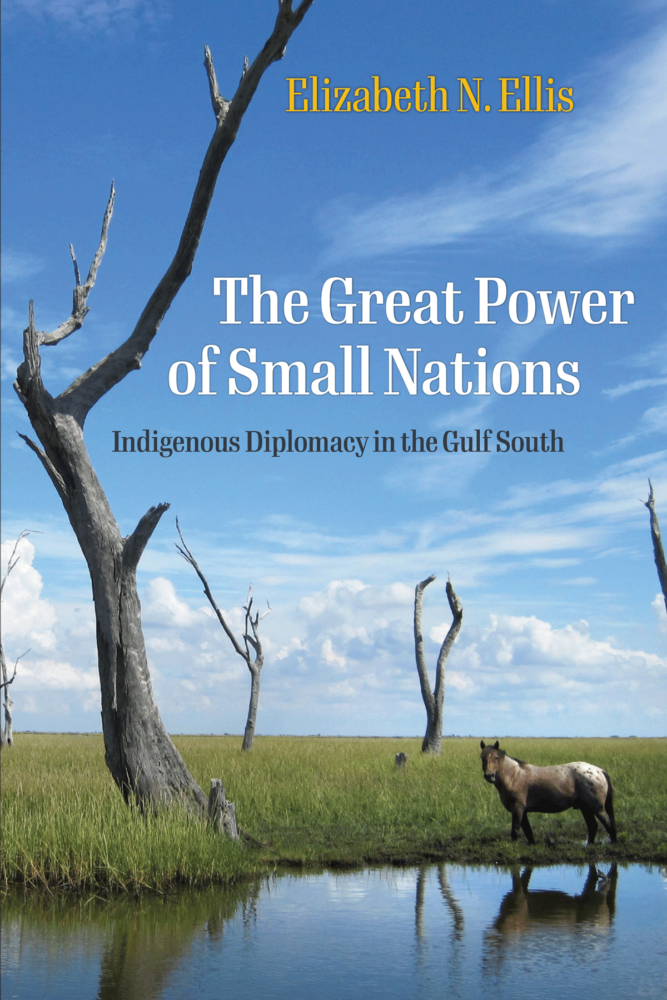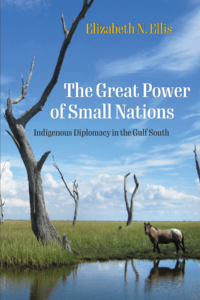Indigenous Internationalism
Elizabeth Ellis’s "The Great Power of Small Nations" named the 2024 Humanities Book of the Year
Published: June 1, 2024
Last Updated: September 1, 2024

University of Pennsylvania Press
The Great Power of Small Nations: Indigenous Diplomacy in the Gulf South by Elizabeth Ellis is the LEH’s 2024 Humanities Book of the Year. Published by the University of Pennsylvania Press, The Great Power of Small Nations reconsiders the role of linguistically and culturally diverse Indigenous entities, such as the Bayagoulas, Biloxis, Mobiliens, Chitimachas, Tunicas, and many more, in shaping life in the lower Mississippi River valley during the seventeenth and eighteenth centuries. Ellis’s close examination of the Native groups French colonizers collectively referred to as “les Petites Nations,” or small nations, reveals complex patterns of settlement, interaction, and influence that will shape future studies of the period for years to come. The following is an excerpt from the book’s first chapter.
In the last decades of the seventeenth century, Moncacht-Apé, a Yazoo man, undertook an epic journey. He left his nation’s homelands just above the confluence of the Mississippi and Yazoo Rivers and set out in the direction of the rising sun. This Yazoo explorer and intellectual was on a voyage to uncover his people’s history and to connect their distant past with their turbulent present. He wanted to know where his people came from, how they had come to live in this place, and what other Indigenous peoples knew of their own origins.
Moncacht-Apé’s people were living through an era of momentous changes. During the 1600s, the steady growth of British, Spanish, and English settlements, along with the expansion of Haudenosaunee (Iroquois) power, transformed the geopolitical landscape of eastern North America. Then, in the second half of the seventeenth century, the development of the English colonies of Virginia and Carolina facilitated the growth of a wide-ranging traffic in enslaved Indigenous people across the Southeast. These trades in stolen Native women, men, and children carried violence and disease across the Gulf Coast and into Petites Nations territories. Meanwhile, Native nations who formed partnerships with English traders, like the Chickasaws, grew powerful and turned new European weapons against their southeastern neighbors. To protect their people from the violence unleashed by the slave trades and colonial incursions, the Yazoos relied on the time-honored practices of providing refuge for migrants and living in multinational settlements. Perhaps in order to make sense of the tumultuous present, Moncacht-Apé wanted to understand the past and his people’s place among the many societies of Native North America. Interpreting Moncacht-Apé’s world therefore requires attention to both the specific cultural and political contexts of the Lower Mississippi Valley as well as an examination of the wider transnational processes that transformed the Southeast in the late seventeenth century.
In the 1670s, the Yazoos lived alongside four other Petites Nations. Together, the Yazoos, Koroas, Tioux, Grigras, and Tunicas formed a cluster of settlements that contained about 3,500 people. As Moncacht-Apé walked through neighboring towns to buy salt or visit with friends, he would have heard women pounding corn and chatting in Tunica, his kinsmen calling greetings in his own Yazoo language, and foreign travelers selling hides or negotiating for bear grease in the Mobilian trade language that served as the lingua franca in the region. Growing up in this international hub, Moncacht-Apé frequently dealt with foreigners and heard stories of faraway lands. These moments must have sparked his urge to travel to see the wonders of the continent and its peoples for himself.
As a young man, Moncacht-Apé left the multinational settlement where he was raised and set off across North America to uncover his people’s history. He bid his wife and children farewell and journeyed east. Walking barefoot or in soft hide shoes, Moncacht-Apé relied on the well-trod pathways of the eastern woodlands to guide him to other Indigenous historians. This expedition would take him years and teach him much about the continent and its peoples.
Moncacht-Apé made the first stop of his grand tour at the nearby Chickasaw towns. He was likely impressed by the size, wealth, and grandeur of the Chickasaw nation. Perhaps he noticed that some men carried burnished muskets or that elite Chickasaw women wore brightly colored European manufactured cloth. The Chickasaws were allies of the Yazoos, so they welcomed Moncacht-Apé hospitably and entertained his requests for information. Moncacht-Apé explained that he wanted to know more of the region’s history, and he asked the Chickasaws “if they knew where we all came from.” His Chickasaw hosts knew the stories of their own people’s emergence and migration to this land, but they did not know the history of the Yazoos. Instead, they advised Moncacht-Apé to travel further north and east and to consult the peoples of that region. As he set out, they also cautioned him to travel carefully and to take paths that would “avoid passing by the big villages of the whites.” They were not sure that these “Blancs” (Frenchmen) would receive him kindly. Moncacht-Apé heeded the Chickasaws’ counsel and kept to the routes that circumvented the French towns in Illinois and along the Great Lakes.
By relying on Native knowledge, hospitality, and networks of political connections, Moncacht-Apé was able to travel as far north as Niagara Falls and as far east as the Atlantic Ocean. As he wore out his shoes along the rocky paths of the eastern woodlands and sat with new friends beside small fires in the evenings, he shared stories of his people. In return, he gained a vast political and environmental knowledge of the continent and learned fragments of foreign languages and histories. Moncacht-Apé’s journey east led him through more than nine different nations. He crossed through Shawnee lands in the Ohio River Valley, Haudenosaunee homelands in what is now Upstate New York, and along the peripheries of the growing English colonies in the Northeast. He then trekked through the frigid Northern Abenaki territories until he inhaled briny sea mist and gazed upon the roiling blue of the “great water.” Moncacht-Apé must have felt exhausted as he watched the waves crash onto the shore and stared out at the expanse. Despite all of his travel, he still could not find anyone who could tell him precisely where his own Yazoo people had originated.
While Moncacht-Apé traveled east across the continent, new epidemics and shockwaves of colonial violence rippled west from the Eastern Seaboard, leaving death and destruction in their wake. As he journeyed, he took care to avoid villages where smallpox or influenza were raging. During Moncacht-Apé’s time away, disease and raiders brutalized his own community. When he returned home, Moncacht-Apé was devastated to discover that his wife and children had died in this time of great suffering and illness. They may have been taken by one of the waves of disease or slave raids that scythed down the Mississippi Valley during this era. Like so many Native communities in the interior of North America, the Yazoos experienced European pathogens and epidemics long before they encountered flesh-and-blood colonists. Both were deadly.
Moncacht-Apé fled his grief by throwing himself back into his mission. Again, he left his hometown in search of his people’s origins, but this time he went west. He passed through the Quapaw, Missouri, and “Otter” nations in the windswept grasslands that are now Arkansas and Missouri and continued walking north through the territories of Northern and Western Plains nations. Finally, Moncacht-Apé stopped at a village a few days’ journey away from the Pacific Ocean. His Native hosts warned Moncacht-Apé to be wary of the pale-skinned travelers who came on ships. These men had long, black beards and they covered almost their entire bodies in brightly colored fabrics. Even their feet were bundled in gold and red-hued cloth. Moncacht-Apé’s Native hosts explained that these men came for a pungent yellow timber that could be used to make dye for their clothes. In addition to wood, however, the unwelcome invaders also came ashore to capture young people who they could traffic throughout the Pacific world. During one of these marauding seafarers’ visits, Moncacht-Apé’s hosts asked for his help defending their community. When they asked Moncacht-Apé to accompany them on a raid against these men who stole their children, he remarked that “my heart found that it was good for me to go with them,” and Moncacht-Apé fought alongside his new friends. He may not have been able to protect his own children and his homeland, but he could fight for others. It is likely that he found comfort, on this distant Pacific coast, as he helped other Indigenous families defend their sons and daughters.
It took Moncacht-Apé “thirty-six moons,” or roughly three years, to make his journey to the West. Back in the Yazoo village, he sat up with his old friends and talked of his adventures. The knowledge he carried home earned him a reputation as a renowned linguist and scholar. The stories of his extraordinary voyages traveled beyond Native networks and reached French settlers. In later years, they sought him out for his expertise on the region and its history. During the 1720s, Moncacht-Apé sat down with the colonist Antoine-Simon Le Page du Pratz, who recorded some of these stories and published them in a memoir of his time in Louisiana.
Moncacht-Apé’s story provides a window into the wide world of the Petites Nations. He traveled through the lands of more than a dozen Native nations, and he collected intelligence about English, French, and possibly Japanese or Russian colonial schemes. As Moncacht-Apé’s experiences illustrate, his people were part of far-reaching networks of Native economic, diplomatic, and intellectual exchanges. The Yazoos lived in the midst of an Indigenous borderland that brought them into regular contact with foreign diplomats, travelers, and traders. At home, they existed in a vibrant polyglot and multicultural settlement that was built on relationships of interdependency with their neighboring nations.
Elizabeth Ellis, PhD, specializes in early American and Native American history in the seventeenth and eighteenth-century South and currently serves as an associate professor of history at Princeton University. In addition to her work on early America, Ellis writes about contemporary Indigenous issues and political movements and is committed to organizing and fighting for Indigenous self-determination. Her ongoing collaborative work includes the Reclaiming Stories Project, the “Unsettled Refuge” working group on Indigenous histories of North American Sanctuary, and the “Indigenous Borderlands of North America” research project. She is Peewaalia and is an enrolled citizen of the Peoria Tribe of Indians of Oklahoma.
